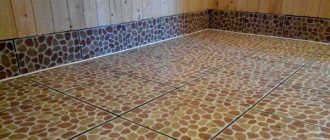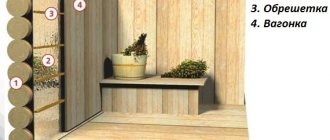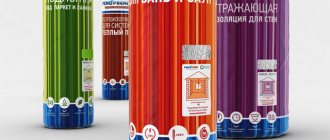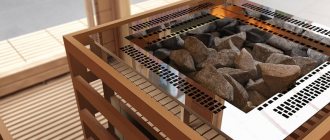Heat from porcelain stoneware in a steam room - experiments and results
I bought a box of porcelain stoneware 60x60x10 mm.
x 4 pcs. 570 rub. for 1 m2 - whitish speckled. I laid out the tiles on the top shelf = 1m from the floor. I started heating the bathhouse. This time there was a constant flow of air under the bathhouse through a window in the sink - ventilation a la Alexander from Donetsk. I’ll immediately report the conclusion - the steam room warmed up more slowly and the maximum temperature in the mode = closed door and NO ONE with the most intense heating did not exceed 73-75 degrees at a height of 140 cm. In the “operation” mode, the temperature froze at 58-60 degrees. The porcelain stoneware slabs - brought in from the cold - warmed up very quickly. The tiles and wooden shelves reached a temperature of 40-45 degrees at the same time.
Separately, I measured the temperature of porcelain stoneware and wood in the strong IR zone - 40-50 cm from the pipe with t = 300 degrees. So - the temperature in the range of 40-50 degrees of the material was absolutely almost the same for both objects. The air temperature during the warm-up stage was 20-25 degrees. Once again I was convinced of the very soft heat from porcelain stoneware at a distance of 30-50 mm at a temperature of only 40 degrees.
Cooling down - stopped heating the stove for 20-30 minutes during the warm-up stage. The temperature of porcelain stoneware decreased from 48 degrees. up to 43-45, and wood - up to 41-42 gr. But - the porcelain tiles, with most of their area, were closer to the stove. Additional heat transfer was possible.
The next stage is to lay the tiles again on the top shelf. The temperature of porcelain stoneware and wooden shelves is 48-49 degrees. Well, I think I need to lie down again. Wig-you.. Even the palm of the ceramic burns. I try to douse myself with cold water and plop down from acceleration - we are “steelworkers” - wig-you. Okay - I cover the tiles with a terry towel - wow. I pour two splashes of cold water over the tile and get a hot water cushion on the tile.
The last combination - I douse myself + two ladles of cold water + a towel - I lie there for 2 minutes - my back really gets welded. That's it - the experience is over. The result was that on the second day my back really burned from the heat, but it didn’t hurt.
Notes on condensation.
As I already described, condensation can be observed on porcelain tiles even when warm – at 40 degrees or more.
This time an interesting phenomenon was noted. There were 2 slabs on the top and bottom shelves. The temperature on the top tiles is 45 – add 1 liter. We get condensation on the upper ones and complete absence on the lower ones. I throw another 1+1 l=2 - there is no condensation on the lower tiles. WHY?
I'll have to buy another pack of tiles for the walls.
The solution to this problem is to make additional supply windows in a brick screen - right at floor level.
Choosing material for walls of various rooms
The most popular and suitable types of tiles:
To cover the shower walls, glazed cladding is used, the elements of which can be of various shapes, colors, glossy or matte, with relief, patterns - this is determined by the design of the room. If there is a pool, its finishing is made of similar materials.
Advice! Porcelain tiles, due to their qualities and durability, are a good solution for finishing the walls of wet rooms. With its help, you can imitate various types of natural stone or wood, but the cost of finishing increases.
The presence of a stove in a bathhouse automatically implies an extremely high temperature, so its lining must be heat-resistant, durable, not highly porous, and have a thickness of at least 8 mm. Several types of materials have the corresponding characteristics:
Advice! It is not recommended to use paired tiles to finish surfaces - if you choose them incorrectly, you can easily get burned. But, “if you really want to,” it is necessary to leave several samples of different compositions in the room until it heats up to its maximum—you can only use the material that was able to maintain an adequate temperature during the test.
The dry rooms of the bathhouse - the relaxation room, the dressing room - can actually be covered with any tiles that meet the basic requirements. In these areas, special attention is paid to interior design.
Preparatory work
When laying tiles on brick or block masonry, the surface is first cleaned of dirt. Then the wall is roughly plastered with preliminary wetting with a spray and smoothing out defects, the differences of which are 10-15 mm or more. While the solution has not hardened, small notches are made on it with a trowel or spatula - this will improve the adhesion of the tile adhesive to the surface.
For walls made of timber, almost any modern waterproofing roll material is first installed on them, onto which a reinforced mesh is attached. For the steam room, it is only possible to use foil sheets, preferably containing kraft paper. Cement plaster is applied on top with a layer of 15-20 mm.
Laying out the surface is carried out by installing beacons along its perimeter and stretching a fishing line between them to control the evenness of the laying during the work. In the case where the design project provides for the creation of a pattern, it is necessary to carefully apply the entire layout of the cladding elements.
Important! Before laying, the tile must be immersed in a container of water, where it should remain until air bubbles stop rising from it.
Creating a tiled floor
Laying tiles in a bathhouse requires preliminary preparation of cinder block or brick surfaces. If there is grease, dust and other contaminants on the wall, you should wash them off until the stains and dirt are completely gone. Then the surface is leveled with the solution using a sprayer. There should be no roughness or depressions larger than 10 mm on the wall. In construction, such work is called “rough plaster”.
After such plastering, notches are made on the wall to strengthen the tile more firmly. The notches are made with a spatula. You can also use a trowel instead of a spatula.
If the bathhouse is built from timber, then before laying the tiles on the walls, they are waterproofed. It is performed using roofing felt or other roll-type material. Then a reinforced mesh is attached to the roofing material. You can replace the reinforced mesh with a chain-link mesh with a fine mesh. A layer of plaster with a thickness of at least 15 mm is applied on top of the mesh. Then they begin laying the tiles.
Tile can be laid in three ways:
- Diagonally. In terms of complexity, only experienced craftsmen can do it. In addition to the time and hassle during the installation process, the consumption of tiles will also increase - the diagonals must be adjusted perfectly.
- "In a running start." The process of bricklaying is similar: the top row is offset relative to the bottom by a distance of half a tile. At the same time, the human eye does not notice irregularities in the vertical rows.
- Seam to seam. The most popular of these types of styling. Here you can distinguish asymmetric and symmetrical masonry. When performing symmetrical masonry, tiling is carried out in the direction from the middle of the room to the corners, with asymmetrical masonry - exactly the opposite.
For masonry, a cement mortar is used (it is advisable to use grade 300 or higher, the ratio of cement to sand is 1 to 5, respectively. For those looking for an easier option, you can use a ready-made adhesive for tiles. Industrial adhesives for tiles are made using cement with the addition of special polymer substances that improve its durability.
Since the tiles begin to be glued from the bottom up, the laying of the bottom row should be done especially carefully. The master should place the upper rows, focusing on the lower ones. A metal UD profile is used, which is fixed around the perimeter of the room at the required level.
For even laying of tile rows vertically and horizontally, a laser level (level) is an excellent assistant. The installation process will be under control when using a level. Craftsmen note the ease of operation when using this device.
Excess glue is removed from the tiles before it dries using a rag. A tile cutter is used to cut tiles. If you don’t have this tool, you can take a small grinder with a diamond blade.
After completing the installation, it is worth cleaning the seams of the tile rows, then covering the seams with jointing.
In Russian bathhouse traditions, it is not customary to use tiles to cover the floors in bathhouses. Despite this, lovers of steam baths still opt for a ceramic floor. When creating it, craftsmen take into account the type of floor base (concrete or wood) and its slope towards the drain. Let's consider creating varieties of tile floors.
Flat floor
Before laying ceramic tiles, preliminary preparation of the floor base in the bathhouse should be carried out. The next step is marking the floor. It is done if you plan to lay out a tile pattern on the floor.
If the installation is made of single-color tiles, then markings will not be required. In this case, the floor is laid with tiles, starting from the front corner of the room. The adhesive used should be diluted in water according to the instructions for use on the package. To mix and obtain a homogeneous composition without clots, use a construction mixer or drill with a special attachment.
First, the adhesive is applied to the area of the floor required to lay 4-6 tiles. To apply it, use a medium-width spatula or trowel. Then the applied layer is spread with a toothed spatula.
The adhesive is also applied to the back side of the tile using the same spatulas (flat, then serrated).
With drain
Laying tiled floors in a bathhouse requires a slope towards the drain. For guidance, craftsmen use either a building level, a fishing line, or a block with the desired slope. It is placed on the tile, and then measured on top of it with a building level. The tiles are cut with a special tool - a tile cutter; the holes for the drain are cut using a drill with a core drill.
If the drain in the bathhouse is located in the middle of the room, then laying the floor with tiles begins from the central part (from the place of the drain). In this case, the required finishing slope is formed. First, the tiles are laid out without glue to more accurately measure the required slope.
On the concrete floor
First of all, the entire area that is planned to be tiled is cleared of debris and dirt. You can use a vacuum cleaner for this purpose. After cleaning, you should seal the cracks, crevices and flaws in the base of the floor and at the junctions of the walls and floor with sealant. When the sealant has dried, remove any excess. Then a ready-made liquid primer is applied to the base of the floor. The required height of the primer layer is 20 cm (measured along the wall).
After the soil has dried, the floor should be waterproofed. For such purposes, it is practical to use rubber or so-called liquid glass. These waterproofing compounds are applied to the base of the floor using a wide brush in two or three layers. Then you need to let them dry. The tiles are laid on the floor prepared in this way according to the usual pattern.
On a wooden floor
The wooden base boards must be of good quality and condition, not rotten. If there are damaged boards, they should be replaced. The best option is to completely disassemble the base, lay down insulation, remove varnish and paint from old boards, and treat the floorboards with an antiseptic. Gaps of 3–5 mm should be left between the floorboards. Fill these holes with foam.
Then you need to fill all the holes, apply latex impregnation or heated drying oil to the boards. This will be the first layer of waterproofing for the wood floor. The second layer is performed using fluid or bulk components or roofing felt or other rolled materials.
The next stage is the screed. A metal mesh is installed around the perimeter of the bathhouse, which contributes to the stability of the screed. Filling is carried out taking into account the slope towards the drain. Laying tiles on a wooden floor is done in the usual way. Of course, taking into account the slope towards the drain.
Tile is a practical solution for finishing a bath. It is durable, wear-resistant, aesthetically pleasing, easy to clean, and most importantly, it fits perfectly into a “water” room such as a bathhouse or sauna. And it is quite possible to lay tiles with your own hands on any floor: both wooden and concrete. And even the presence of a drain in the bathhouse will not be a hindrance - you will get a perfectly flat plane.
note
The floor in the bathhouse under the tiles is made level, but in the steam room or washing room a screed is poured with a slope towards the drain.
Using tiles is the most profitable financially, since installation is carried out using an inexpensive adhesive mixture, which is diluted with water.
Work order
Even when purchasing, it is necessary to check the evenness and consistency of the sizes of the facing elements with each other, for which they are selectively applied to each other with their backs - they must be strictly the same. This circumstance and strict adherence to installation technology are a guarantee of long-term preservation of the coating.
Step-by-step instructions for laying tiles:
Advice! You can use a laying solution made independently from a mixture of cement grade at least 300 and sand in a ratio of 1/5. But the best solution is to purchase ready-made tile adhesive, since modern compositions include various polymer additives that significantly improve their qualities.
Attention! During the laying process, it is necessary to control the flatness of the surface and the evenness of the rows using a level and plumb line.
After the glue has hardened and the plastic crosses have been removed with a rubber spatula, grouting is done. Its color is chosen in accordance with the design idea and can be the same color as the tile or contrasting.
Do you need tiles on the wall in a bathhouse: characteristics and features of choice
The bathhouse is one of the obligatory attributes of life for many residents of our country. Naturally, the issues of its arrangement and, in particular, the problems of finishing remain relevant. For many years, wall tiles in bathhouses were extremely rare or absent altogether. The only option that was considered normal was to cover the bathhouses with wood.
Many people think that it is almost impossible to come up with something new in this area. This opinion is wrong. Today, with the emergence of new trends in design and the spread of new types of baths in Russia (hamam, thermal baths, Japanese baths, etc.), the situation has changed. Let's talk about whether there is a place for tiles in a bathhouse and, if so, what criteria should be used to choose this material when purchasing.
Professionals answer questions
Often, people who want to do repairs themselves have questions that cannot always be answered. At our request, the professionals provide an explanation.
The tiles adhere perfectly to this leveling mixture. When the surface is too smooth, adhesion can be improved by notching the wall. If the wall is leveled immediately before installing the tiles, then you need to take into account how long it takes for the rotband to dry under the tiles.
Let's start with the fact that it is not at all necessary to plaster a wall made of foam blocks. When the surface is flat, it is enough to prime it thoroughly, and after drying, glue the tiles. If the wall is uneven, then it can be plastered with gypsum plaster, with a layer of at least 10 mm.
If the bathhouse is built from GGP (gypsum blocks), then preference is given to gypsum-based assembly adhesive. When gluing to foam or gas blocks, a cement-based composition is used.
There are bath floor tiles on sale, equipped with a special system called “Anti Slip”. These floor tiles are completely safe. Even before firing, a thin layer of a special composition with minerals is applied to the glaze. During firing, they change the properties of the glaze, resulting in a relief texture.
You need heat-resistant tiles for a bathhouse, with the same coefficient of expansion as the material from which the stove is built, otherwise the coating will not last long. The tiles in the bathhouse will last a long time only if you follow the tips and recommendations given in the article.
In what kind of bath are tiles appropriate?
The answer to the question in the title will be simple: any. It's a matter of nuances. The problem must be solved based on which particular bath room the tiles will be used to decorate. For example, ceramic tiles on the wall or even on the floor in a steam bath are completely inappropriate for many reasons, although there are “experts” who try to use ceramics in this way. However, both in a Russian steam room and a Finnish sauna, given the temperatures in the steam room, accidental touching of the ceramics can result in very serious burns.
It is possible to use tiles and artificial stone to a limited extent to decorate a small area directly adjacent to the heater and stove (in stove-heated bathhouses) - and then mainly for fire safety purposes.
Ceramic tiles look quite aesthetically pleasing and go well with wood paneling .
But even in baths of this type, tiles can be used with great success to decorate all other rooms: And certainly it will be completely appropriate in a hammam and Roman baths, fitting exactly into the general style of their design. But in a Japanese bath, ceramic tiles will look alien, although they are suitable in terms of their functional characteristics. But the aesthetics of design
The Land of the Rising Sun is an essential component of the bath procedure, and it is apparently not worth abandoning it for purely utilitarian reasons.
Wall installation
Here, unlike the previous option, you can apply the adhesive solution directly to the tile, and not to the work surface. This will make it easier to attach the material. It is worth noting that the composition of the mortar for the wall should be more rigid, that is, there will be less sand here.
Otherwise, working with tiles on the wall is no different from the same process on the floor. Here you also don’t need to forget about the seams and use special limiting crosses for this. In order for the tiles to lay as evenly as possible, they must be periodically checked with a building level.
The work of laying tiles for lining a stove in a steam room is no different from working on walls. The only difference is in higher quality materials that are more resistant to temperature changes.
It should also be noted that the tiles for floors and walls are somewhat different in appearance. Elements of a larger area and with slight roughness are used as flooring. This makes a wet floor safer as it becomes non-slip.
Source
Advantages of ceramic tiles
We can say that ceramic tiles and artificial stone are an almost ideal choice of material for decorating the walls of any bathhouse room, except for the steam room. It is not for nothing that tiles and other types of tiles are always used in rooms with high humidity levels. In the bathhouse, temperature fluctuations are also added to it, however, even to this factor, ceramic tiles demonstrate enviable resistance.
Among other things, this is a very hygienic material that does not retain dirt well, and the tiles are extremely easy to clean. It is environmentally safe and contains no harmful components that could be released when heated. However, today there are a great variety of varieties of this material, so we will discuss which type of material is suitable for finishing bath rooms.
Surface preparation
Preparatory work for different baths differs depending on the material from which they are built. So in brick or block buildings the whole process will be reduced to removing dirt and dust from the foundations. It is also necessary to remove existing oil stains. All surfaces must first be insulated so that the owners simply do not freeze during water procedures. In such a bathhouse, all work related to the slope of the floor, when it is covered, has already been completed at an earlier stage of construction.
Source
Choosing the right tiles for a bath
The important characteristics of tiles made from ceramics are:
It is these parameters that determine the durability, cost, and aesthetic appeal of the material, which are of most concern to end consumers.
So, what types of ceramic tiles can modern trade offer customers:
How to choose
So, we found out that it is better to use glazed tiles for finishing a bath. When choosing specific samples, you should definitely inspect their base. It should not be too porous, as this reduces the strength and durability of the material and can serve as a convenient breeding area for fungus. An important characteristic is the ability of ceramics to absorb moisture. These types of material are marked either “AI” or “BI”. However, it should be taken into account that cutting such tiles is quite difficult.
“A” or “B” is a reflection of the manufacturing method; for the consumer there is not much difference between them.
It is also worth first stacking two tiles with sides facing each other, and then placing one on top of the other. If the connection is smooth and the overlap is complete, these are quality products that will suit you. Tiles with defects will create a lot of unsolvable problems during installation; it is better not to purchase them. Such a characteristic as “wear resistance” for wall tiles is secondary and you don’t have to pay much attention to it. The presence or absence of relief is also not important, although smooth tiles usually last slightly longer than textured ones. The dimensions of an individual product are also not very important, although large tiles are laid faster. Well, the colors are generally entirely at the discretion of the buyer: his bathhouse is his tastes.
Of course, all the nuances regarding the choice of tiles for finishing bath rooms cannot be outlined in a fairly short text; a fairly thick brochure would be needed for this. But I think that we have given you at least the most general idea of the problem of choosing tiles for the walls of a bathhouse.
Features of choosing the type of tile for a bath
The specifics of any room, to one degree or another, dictate the requirements for the selection of finishing materials. It's time to figure out which types of tiles are suitable for use in a bathhouse, and which ones are best left for more favorable conditions.
Which tiles are suitable for a bath
A bathhouse is a zone with “extreme” conditions: humidity is too high, temperature changes are critically sharp. And if wood is considered the best material for finishing a steam room, then facing tiles are more suitable for a shower room, dressing room and rest room. It is easy to clean, is not affected by the surrounding humid environment, does not emit harmful fumes when heated, and does not lose its presentable appearance due to sudden temperature changes.
As you know, tiles can be very different. Its differences are not limited to the color palette, texture and size. Performance characteristics are still considered a more important criterion. There is an opinion that it is customary to use only glazed tiles to decorate a bathhouse, but this is not true.
Let us remember that in most cases, to make unglazed tiles, refractory clay and high firing temperatures are used. This in itself makes this material most suitable for installation in rooms with high temperatures. Unglazed non-slip tiles for bath floors are considered many times safer than many smooth types, because their rough surface will easily eliminate the possibility of falling on a slippery floor.
When choosing tiles for a bath, the level of moisture absorption plays an important role. If we take the average indicator, then unglazed Metlakh material is considered more suitable than some types of glazed ones.
The only drawback of this coating is the uniformity of the color palette. But in a bathhouse environment this is most likely an advantage. The tiles will not attract too much attention, leaving the emphasis on the wooden surfaces.
Which tiles are not suitable for a bath?
There are several types of material that are completely unsuitable for installation in a bathhouse. Their quality can be quite high, but the technical characteristics are prohibitive for sudden changes in temperature and high humidity levels.
Let's look at these features in more detail:
- Glazed tiles are not suitable for finishing a protective screen over a heater or stove. Over time, it will begin to crack and crumble under the influence of high temperature.
Porcelain tile is a material with a high density and a fairly smooth surface. There is no place for it where there is high humidity. As a floor covering, porcelain tiles run the risk of causing many traumatic situations.
Smooth tiles are also not suitable for sinks and showers. Neither for laying on the floor nor for mounting on walls. Slippery wall surfaces can also cause injury.
Steam room
For the interior decoration of the steam room, only deciduous wood is suitable. This type of wood does not heat up, does not emit resins, and, importantly, even with light ventilation it dries very quickly, preventing dangerous fungus from developing. We list the most common types:
- linden – visually attracts attention, does not darken over time, has low density and heat capacity: it heats up quickly, but it is impossible to get burned on contact. When heated, it releases a pleasant delicate aroma. Linden finishing is quite popular, so it is quite affordable.
- aspen is a common material for northern regions. The wood is durable, difficult to split or split, and has bactericidal properties;
- alder – has a beautiful appearance, is pleasant to the touch, resistant to cold and hot water, condensation and steam, alkaline and acidic detergents, and is easy to process.
- Abash is a tree from the tropics of Africa. Even in the hottest heat, it hardly heats up and maintains a temperature close to the human body temperature. Even under the influence of external factors (water, temperatures and steam) it does not darken at all.
Important! Wood cannot be coated with varnish or paint, even of the best quality. When heated, they release an unpleasant chemical odor. During the installation process, nails (screws) must be covered at the top and set deeply, otherwise they may burn when heated. It is better to mount the lining vertically, as drops formed by condensation will drain faster. The junction of the floor and walls must be protected with high skirting boards made of a waterproof material.
Typically, the steam room has wooden floors made of hardwood. But still, tile will be preferable. It washes well, dries quickly and is resistant to fungus. If this coating seems cold to you, you can put a removable wooden grate on top.
How to choose tiles for a bath
The main thing to remember when choosing tiles for a bath is that shape and color do not play a decisive role. Only the speed and degree of complexity of installation of the coating depends on these criteria. Drawings and patterns are important in other, more convenient and practical rooms - in the bathroom, kitchen, etc. For different zones of the bath, technical and operational characteristics are still considered paramount.
Bathroom wall tiles
When choosing tiles for the walls of a bathhouse, you should pay attention to a couple of popular and, most importantly, suitable types for such a room:
- Glazed ceramic tiles are a material that is highly durable and resistant due to double firing. The tiles are covered with a protective glaze, complemented by patterns and ornaments for greater color and species diversity.
Unglazed ceramic tiles. Ordinary tiles, not covered with glaze, are only suitable for installation in warm, dry rooms.
Floor tiles for baths
The tiles in the bathhouse, located on the floor, are exposed to the most aggressive effects. This means that more stringent requirements must be put forward for such material. Ideal for finishing bath floors, a material with a low level of moisture absorption, high wear resistance and sufficient strength is suitable. Moreover, the tiles should never be slippery.
No fewer criteria are put forward for the quality of adhesive for laying tiles in a bathhouse. It must firmly hold together and withstand high levels of humidity. The mortar for laying tiles should not harden too quickly. Otherwise, the possibility of correcting an incorrectly positioned fragment will be excluded.
Bathroom shower tiles
Using tiles in the design of a shower in a bathhouse has its undeniable advantages. Thus, tile covering can be called hygienic, resistant to different temperatures and moisture, affordable, varied in terms of shapes and colors, and certainly durable. But only when the choice is made correctly and the material is correctly laid out.
In addition to the fact that the coating in a wet room should not be slippery, it must also meet aesthetic requirements. This time, staying in the shower will not only be safe, but also comfortable.
Tiles for use in a shower can be:
Glossy surfaces reflect light well and do not require much maintenance. For floors, glossy tiles are not the best option, as they are considered slippery and dangerous. But for the camp it is perhaps the best choice.
Matte tiles, in turn, solve the problems of slippery surfaces. If at the same time it also has some relief, the grip on the soles will be better. In addition, relief surfaces can easily imitate stunning visual effects: natural stone, natural wood, etc. Often, bathhouse owners prefer to combine tiles of different colors, sizes and textures.
Tile for steam room in bathhouse
Tile, in fact, is not considered an acceptable material for finishing a steam room. If you make the wrong choice, you can get seriously burned on the wall and floor of the steam room, for example. But there are still owners who choose tile coverings for installation in steam baths.
The only correct solution is to check the material before installation. So, say, you can take several options of tiles of different composition and texture and leave them on a shelf or on the floor of the steam room at the moment of the highest heating. If the material does not heat up and maintains an adequate temperature, you can use this type for finishing.
Tiles for the stove in the bathhouse
Since a fireplace or stove in a bathhouse itself implies the presence of an incredibly high temperature, strict requirements are imposed on the finishing material. It must certainly comply with the following points:
- Durability and strength;
Thickness not less than 8 mm;
It is heat-resistant tiles for a bath that are suitable for finishing a stove, if we talk specifically about the tile covering. Several types of ceramic materials have these properties, including clinker tiles, terracotta, tiles, majolica, etc.
Let's look at the features of each material:
- Terracotta tiles for baths
. A product with high porosity and no glazed surface. Externally it has a bright brown color and sufficient strength. Terracotta tiles do not crack when exposed to high temperatures, so they are excellent for finishing a sauna stove. Ideally, it is better to give preference to this type of material with a thickness of at least 8 mm and a suitable composition (including refractory clay, quartz and fireclay sand).
Clinker tiles for baths
. A finishing material made from several different types of clay. It is characterized by incredible heat resistance, high strength, low porosity, and the presence of many options in natural shades. The thickness of the clinker tiles is 9-12 mm, which is considered optimal for finishing the stove. Today, this type of ceramic product can be called the most durable.
Coil tiles for baths
. A product made from a semi-precious rock mineral. Laying tiles in other rooms of the bathhouse is too expensive, so it is used only for finishing the sauna stove. In fact, the serpentine is a miraculous stone. When heated, its therapeutic effect is significantly enhanced; the material normalizes blood pressure and increases blood circulation in the brain.
Features of using coil tiles for a bath are outlined in the video:
Porcelain tiles
The use of a floor covering with a smooth surface is unacceptable where there is high humidity, but structured porcelain stoneware is quite suitable for a bathhouse floor. For walls, you can use porcelain tiles with a glossy surface. A large selection of sizes and textures makes it possible to realize your desires when creating the intended room design.
The undoubted advantage of this facing material is its lowest level of water absorption, therefore, when using frost-resistant glue, porcelain stoneware will withstand large temperature changes and will not collapse.
Many people, if not most, purchase tiles for a bathhouse in order to subsequently use it for cladding floors and walls. If this facing material is used as floor tiles in a bathhouse, then a non-slip surface is selected. You also need to pay attention to the level of water absorption - it should be minimal.
When choosing tiles for the walls for a bathhouse, less stringent requirements are imposed on it, but if this room is unheated and there will be sub-zero temperatures in winter, then preference is given to a material with a minimum level of water absorption.
Tile comes in different sizes, but there is a facing material that has only its own distinctive features. For example, boar tiles can be used in a washroom, since its unique shape gives this room a special flavor.
If the bathhouse is made in the Turkish style, then mosaics are often used for cladding. Modern technologies make it possible to carry out repairs much faster than it was done in the last century.
How to choose tiles for a bath or sauna
The floor in the bathhouse can be wooden or concrete. A wooden floor, of course, requires attention and proper care, but walking on it is pleasant and safe, and it is better to lay ceramic or natural tiles on a concrete floor. Both from an aesthetic and practical point of view, this option is preferable. The walls are also often tiled. Especially in the washroom.
It is better to lay ceramic tiles on a cement floor in a bathhouse.
Some prefer to tile the walls of the steam room to a certain not very high height: it is the cladding that is not high from the floor that begins to deteriorate and after a while requires replacement, and tiles save us from such a nuisance. It is necessary to take into account that there are many types of ceramic tiles and not all of them are suitable for a bath or sauna. We'll talk about how to choose tiles for a bath below.
Types of tiles and their classification
First of all, you need to decide on the type of surface and its density. The surface can be matte or glossy. Ceramic tiles for a bath floor should have a rough surface , i.e. matte. Since it is almost always humid in a bathhouse or sauna, you can easily slip on a glossy one. The type of tile surface is characterized by a friction coefficient, which is designated by the letter R when marked. Glossy options have a friction coefficient of R9-R10, matte - R11-R13.
You also need to pay attention to the porosity of the base. The more porous the material, the more water it can absorb, which is completely unacceptable for us. It is necessary to choose floor tiles with the lowest degree of water absorption. The water absorption coefficient is calculated as a percentage. For baths and saunas, the smaller it is, the better:
For ceramic tiles in a bathhouse there is another important parameter: frost resistance. If your bathhouse is used only seasonally, or constantly, but is not heated, then after several freezing/thawing cycles, ordinary tiles will crack. Therefore, you need to choose tiles with increased frost resistance. But here it must be said that this characteristic is directly related to the ability of the tile to absorb water: the less water is absorbed, the greater the frost resistance of the tile.
The floor in the bathhouse is laid with ceramic tiles
There is also such a parameter as abrasion resistance. All tiles are divided into 5 categories: PEI1-PEI5. Tiles of the first group are suitable for a bathroom or toilet, but they cannot be used for a bath or sauna. The higher the group, the greater the load it can withstand. And you will have to select the required category based on the expected intensity of use of the bathhouse. If only family members come once or twice a week, then the second category is quite suitable...
The technical characteristics of the tiles are clear. You also need to take into account its appearance and quality. If you have little experience in tiling, it is better to choose tiles that are not very large, rectangular or square in shape: they are easier to lay. There are hexagonal and octagonal tiles, and there are collections with tiles of complex shapes, but a professional can handle this task. In general, the sizes of ceramic tiles today are very diverse: from small mosaic tiles to large tiles (50-80cm).
The walls near the stove are often tiled
The quality of the tiles can be assessed by external signs: the corners must be straight and the surface smooth. Take two identical tiles and place them face to face. They must fit snugly, the angles and dimensions match. If everything matches perfectly, the tiles are of good quality.
The tiles for a Turkish bath (hamam) are selected according to similar criteria, but preference for its design is given to mosaics: with its help you can recreate the national flavor.
Tiles for a Turkish bath are selected according to similar criteria, but mosaic allows you to recreate the national flavor
When choosing a tile, do not forget about the accompanying materials: crosses, tile adhesive and grout. Both glue and grout must be moisture resistant and can withstand temperature changes well. To choose the best option, consult the seller on the website
Finishing inside the steam room
Since buildings are made of different materials, owners are interested in whether there is any difference in how to decorate a steam room in a bathhouse, say, from brick or foam concrete. In principle, there are no differences even at the level of constructing an insulating pie, and even more so the finishing does not depend on what the walls of your bathhouse are built from.
However, options do exist.
Interior decoration in a bathhouse made of timber or logs
A beam or log is a material that in itself has excellent decorative qualities, so there is no point in hiding it under the skin, unless your area is in the Arctic cold, that is, if the thickness of the log or beam is enough to keep warm.
In this case, the owner’s main concern will be insulating the joints with inter-crown insulation between logs or beams and sealing them (which we will discuss separately). In addition, finishing works include protecting log walls from various misfortunes (fire, water, insects, fungi and bacteria) and revealing the decorative properties of wood - both are done with the help of impregnations.
BUT! In the steam room, protective measures are limited to antiseptic on the lower rims and impregnation for the walls as a whole, which will protect them from water.
A well-sanded log has a beautiful “moire” pattern, which can be made more visible with the help of varnish or impregnation. On our website parilochka.com there is an article that talks about paints and varnishes that are acceptable for processing steam rooms.
Finishing with clapboard in a bathhouse made of aerated concrete, foam concrete, brick, frame
The finishing of a steam room in a bathhouse built from the materials listed in the title will in the vast majority of cases be reduced to clapboard cladding. This is the easiest way to make the interior “wooden”. In addition, lining is a convenient and affordable material, and the difference in profiles gives the owner the freedom to choose according to his tastes.
Baths not built from wood are usually insulated. In this article we will not describe the thermal insulation pie - you can read about it in this article on our website. However, we will spoil it: methods of thermal insulation finishing of a steam room in a bathhouse made of aerated concrete, foam concrete, etc. are the same. And the lining is the final stage of this finishing.
The lining is attached to the counter-lattice. There are several ways to attach it inconspicuously. Previously, this was most often done with finishing nails through a groove, but this is hard work, especially when compared with the modern method of fastening to staples or nails using a pneumatic gun through clamps. As an option, you can attach it to self-tapping screws.
IMPORTANT! Clippers do not replace fastening with nails or staples, they only simplify it. A nice and convenient addition.. Watch the video, which clearly demonstrates the method of fastening the lining using clamps:
Watch the video, which clearly demonstrates the method of fastening the lining using clamps:
Regarding the finishing of the steam room with clapboard, it is worth saying one more thing: there are two mounting options - vertical and horizontal. Accordingly, the counter-lattice should go in a perpendicular direction.
Since we are talking about a humid and hot room, it is worth noting that vertical fastening of the lining is not optimal. Each individual lamella with this arrangement is moistened unevenly, which leads to stress inside the wood. In the future it may crack.
At the same time, horizontal fastening makes the lamellas moisturized more uniformly. The main thing is not to forget when fastening that the groove should be on top, and the tenon should enter it from below. Then water will not flow into the lock.
In addition to the above, the described types of lining installation also have this feature: vertical fastening visually makes the room taller, and horizontal fastening makes the room appear lower.
What kind of tiles are there?
The abundance of finishing materials today is amazing. In addition to the fact that there are a sea of varieties of ceramic tiles, there are also tiles made from natural materials. For baths, tiles made of coils and soapstone are most often used. These materials have increased strength and heat resistance, and have the ability to accumulate heat. If you don’t know which tile to cover the stove with, choose either a coil or soapstone – you won’t regret it. These materials have only one drawback - a considerable price. No other deficiencies were found.
Coil tiles
The appearance of natural materials is extremely attractive: the coil is painted in different shades of green, and soapstone is gray. Soapstone tiles contribute to a more even distribution of heat, it’s not for nothing that some of the best stones for a bath are made from soapstone.
Soapstone tiles in the bathhouse
Bathhouse coil tiles are most often used for lining the stove and adjacent walls. It ensures fire safety and has a positive effect on well-being: it stabilizes blood pressure, relieves nervous tension, and has an anti-inflammatory effect.
The wall near the stove can also be lined with salt tiles (Himalayan, sea or regular). But the salt tile behaves well in dry air, and in a bath with its high humidity it will gradually dissolve. But even in the sauna you will have to make sure that no drops of water get on the salt.
Pink Himalayan salt in the sauna
What is a salt tile for in a bathhouse? The fact is that it has a positive effect on the body. When heated, salt releases negatively charged ions that disinfect the air. Entering the human body with breathing, they also cleanse most systems (bronchial tubes and lungs, blood, joints and kidneys). The salt is gradually deposited on the skin, also having a beneficial effect on it: it becomes smooth, elastic and velvety. But the main thing here is a sense of proportion: too much salt will not lead to anything good. Also, salt inhalations have a number of contraindications (skin diseases, tumors of various etiologies, pregnancy, feeding, etc.).
Source
Waiting room
The room is not hot, but retains heat. Therefore, coniferous species will be an excellent material for finishing here. Their noble aroma is not only pleasant, but also incredibly useful. Phytoncides have a beneficial effect on the immune system, stimulate the body's resistance to various infections and improve overall well-being. Let's look at the main types:
- Pine is a very popular material for dressing a dressing room, because it has a number of advantages: economical, durable, environmentally friendly and quite durable. May change color slightly over time, acquiring a reddish tint. Scandinavian pine with smooth pinkish wood is becoming increasingly popular. Its annual rings have an original decorative pattern;
- spruce – has a uniform structure, does not crack when drying, and is slightly lighter in color than pine wood;
- fir - the main characteristics are almost the same as spruce, while almost no resin is released from its wood.
Birch is a good option for a deciduous tree for a dressing room. In any case, when decorating, the main thing is to follow the basic rule - the entire room should be paneled with the same type of wood.











